
 A few years ago I was driving through Wadi Hadhramawt, a remote valley in the eastern corner of Yemen that adjoins Saudi Arabia and Oman. It is an area distinguished by ocher-colored cities of towering mud-brick buildings. Surrounding the towns are extensive date groves, irrigated by wells and rain-fed canals, probably thousands of years old.
A few years ago I was driving through Wadi Hadhramawt, a remote valley in the eastern corner of Yemen that adjoins Saudi Arabia and Oman. It is an area distinguished by ocher-colored cities of towering mud-brick buildings. Surrounding the towns are extensive date groves, irrigated by wells and rain-fed canals, probably thousands of years old.
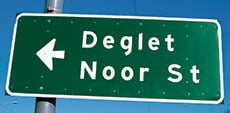 |
 |
| A street sign in Indio, California names the date variety first grown in the United States, planted in the Coachella Valley in 1903 using shoots imported from Algeria. Today it is still the most common variety sold in the US. |
 |
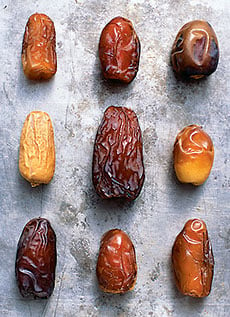 |
 |
| Pride of the Coachella Valley (left to right, top to bottom): halawy, khalasah, barhi, thoory, medjool, zahidi, derrie, khadrawy, and deglet noor. |
It was Ramadan, and savoring a few dates with a sip of water is a common way to break the fast at sunset. One evening, when Abdul Ali, my driver, offered me a plate full of dates, he told me to select just one and not to chew it, but to let it melt in my mouth. I had never eaten a date in this way. At first there was no taste. Then the date gradually warmed. Soon the outer skin began to slide off, and before long, the smooth, soft, dissolving flesh began to fill my mouth with complex flavors of honey, sweet potatoes, sugarcane and caramel. These tastes were soon joined by a more subtle, slightly nutty flavor infused with a rich note of taffy. It took me at least 10 minutes to finish that date. I didn’t think to ask the name of the variety, but one thing was certain: It was like no date I had eaten before.
Certainly my fasting that day had accentuated the experience, but as Abdul Ali and his friends began to discuss the subtle differences among the many varieties, I remembered that dates had been grown commercially in my home state of California since the early 1900’s. I became curious about which varieties of dates were being grown in the United States and how the date palms had traveled there.
Late one night the conversation shifted to a legendary date from Saudi Arabia. In Arabic, Abdul Ali called it khalasah (“quintessence”), and he accented the second syllable: “kha-lah-sah.” Villagers, shopkeepers and other people I met throughout Wadi Hadhramawt seemed to agree that the khalasah was the date against which all others were judged. I learned that the khalasah was one of the most famous dates of the Arabian Peninsula, and that the best ones came from near the town of Hofuf, in the al-Hasa region of Saudi Arabia’s Eastern Province.
A few weeks after returning to California, I started to read up on the history of dates. The commercial date palm, Phoenix dactylifera, is thought to be the world’s oldest cultivated fruit tree. Fossil records indicate that the date palm was common around the Mediterranean and in Mesopotamia as early as the Eocene epoch, some 50 million years ago; among written records, an Akkadian cuneiform text from around 2500 BC mentions the date palm as a cultivated tree. Bas-relief sculptures from the palace of Sennacherib in Nineveh, Iraq, carved in the seventh century bc, clearly depict cultivated date groves.
The date palm grows best between 15 and 35 degrees north latitude, primarily in the arid regions of North Africa, the Arabian Peninsula and southern Iraq, where dates have been a staple food for millions of people over thousands of years. The Food and Agriculture Organization of the United Nations estimates that of the 90 million date palms in the world, 64 million grow in Arab countries. There are approximately 600 different varieties of dates, and the world’s annual date harvest exceeds three million tons.

From my reading, I learned that the Prophet Muhammad had subsisted on little more than dates and water during his years in Madinah, and that he had built the first mosque using date palm trunks for pillars and woven date palm fronds for the roof. The Qur’an, in Chapter 6 (“Mary”), describes how Jesus was born under a date palm, and how the tree dropped fresh ripe dates in Mary’s lap for her to eat—and I knew, from my many visits to Yemen, that villagers believe a steady diet of dates helps a nursing mother produce abundant milk.
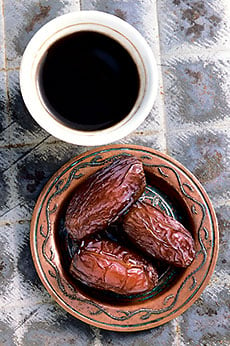 |
 |
| Medjool dates, shown with a demitasse of Turkish coffee, are the number two date crop in the US, and they came to the Coachella Valley from Morocco. |
 |
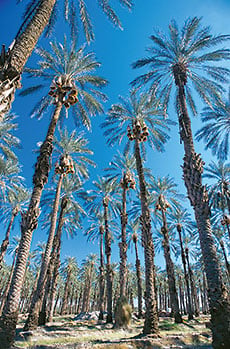 |
 |
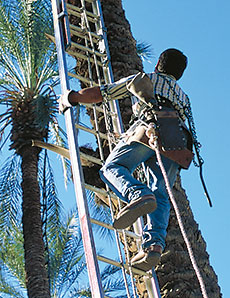 |
 |
| In a grove of mature deglet noor palms more than 25 meters (80') tall, palmeros such as Carlos Rodrigues make more than a dozen climbs annually per tree to pollinate, protect, prune and harvest in stages. |
At a farmer’s market in San Francisco, I met Robert Lower, a grower of organic dates in the town of Thermal in the Coachella Valley—the heart of California’s date-growing country. His company, a small-scale operation, is called the Flying Disk Ranch; he started it in 1979 with a row of palms and one irrigation ditch. At the market, Lower was selling dates with Arabic-sounding names like medjool, khadrawy, derrie, zahidi and barhi. The only one I recognized was the ubiquitous deglet noor, the date most commonly sold in the United States—the one my grandmother would stuff with almonds or a dab of cream cheese at Christmas time.
Deglet noor means “date of light” or “translucent one,” and indeed its flesh is often so translucent that the seed can be seen if the date is held to the light. According to Paul B. Popenoe, author of the definitive Date Growing in the Old World and the New, the deglet noor was developed in the oasis of Balad al-Ahmar in the northern Sahara nearly 400 years ago. Distinguished by a pleasant, nutty aftertaste similar to that of a lightly roasted peanut, it is medium sweet and cures well. A deglet noor palm typically averages more than 45 kilos (100 lb) of dates, but an exceptional tree will produce up to 115 kilos (250 lb) of fruit.
In the California date-growing community, people also use Arabic terms to describe the degrees of ripeness. Kimri dates are green, unripe and inedible. After the dates achieve full size, have started to ripen and are in a fresh, crunchy stage, they are known as khalal. The ripe soft or semisoft stage, which is how most dates are sold in the US, is rutab; these dates are the most fragile and difficult to ship. In the Middle East, rutab dates are carefully graded according to subtle differences in color, complexity of flavor, translucency, freshness, taste, proportion of pit to flesh, skin texture and other exacting criteria. In California, if dates are allowed to ripen to the rutab state while still on the tree, they are known as “naturals.” These are what Lower called “melt-in-your-mouth” dates. Naturals are rarely sold commercially because, within the same cluster, dates ripen at slightly different times and so the harvest of naturals requires repeated visits to the tree. Also, naturals tend to ferment, and do not keep as long as drier dates. The fourth stage of ripeness is tamr. These dates ripen on the tree and are then left there to dry. These are the least perishable dates, and they are the easiest to pick because at this point they are nearly indestructible.
Hanging from a corner post in Robert’s stall, a cluster of firm, round, light-yellow dates caught my eye. These, he told me, were barhi dates in the khalal state. The barhi, known in the trade as “the honey-ball date,” was introduced to California in 1913, originally from Basra in southern Iraq, where it was named after the prevailing hot summer bahr winds near Basra. In the khalal state, the barhi is crisp, fibrous and slightly astringent for the first few bites. Then the sweet sugarcane, baked-apple, cinnamon and coconut flavors begin to reveal themselves. In its rutab, or soft, state, the barhi is dark brown, extremely fragile and tastes more of honey and melted butter.
The barhi is perhaps the most versatile date in the kitchen because it can be eaten in the khalal, rutab or tamr states. Barhis freeze well, and they can be used in cooking. Lower prefers the crisp, sweet taste of khalal barhis, but he also stuffs rutab barhi dates into cored apples and bakes them.
Two Tunisian brothers, Salah and Salam Harati, arrived at Lower’s date stall while I was there. It was clear they were regular customers who knew their dates. They greeted Lower warmly and bought an entire box of khalal barhis to take home to their families.
“These dates? We have them in the morning with buttermilk,” they told me. “Chew, chew. Don’t swallow. Relax your mouth, and then just taste. These dates are the best.”
The brothers and their box of barhis disappeared into the market crowd. Lower suggested that I come down to Thermal to watch the date harvest that was getting under way. Before making the 10-hour drive south to the Coachella Valley, though, I decided to read up on the history of the California date industry.
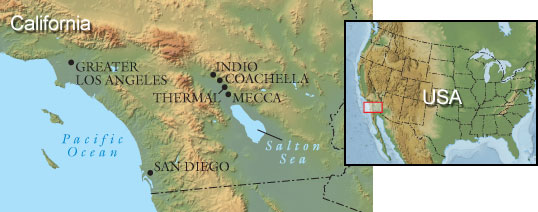
 oday the Coachella Valley is a bit more than an hour’s drive east of Los Angeles, north of the Salton Sea and below the San Bernardino Mountains. The area has very little rain, abundant groundwater for irrigation, good drainage, low humidity and a fairly uniform and intense heat during day and night. Around 1900, it was selected by the United States Department of Agriculture (USDA) and private growers as an ideal region to try growing dates. The first commercial date grove consisted of 129 deglet noor date palm jebbar, or offshoots, from Algeria, planted in 1903 by Bernard Johnson. The next year, the USDA opened an experimental date research station in the Coachella Valley.
oday the Coachella Valley is a bit more than an hour’s drive east of Los Angeles, north of the Salton Sea and below the San Bernardino Mountains. The area has very little rain, abundant groundwater for irrigation, good drainage, low humidity and a fairly uniform and intense heat during day and night. Around 1900, it was selected by the United States Department of Agriculture (USDA) and private growers as an ideal region to try growing dates. The first commercial date grove consisted of 129 deglet noor date palm jebbar, or offshoots, from Algeria, planted in 1903 by Bernard Johnson. The next year, the USDA opened an experimental date research station in the Coachella Valley.
A date palm can grow from a seed, but the resulting fruit is usually inferior in size, flavor and taste to the original palm. A seed-grown palm can also turn out to be either male or female, and only the latter produces fruit, while a single male palm is sufficient to pollinate 50 females. On average, date palms are planted about 10 meters (32') apart. To ensure high quality dates, it is crucial to obtain jebbar from carefully selected, mature female palms of proven fruit-bearing quality. The offshoots grow at the base of the trees, and they can weigh anywhere from 10 to 50 kilograms (22–110 lb), with about 35 kilograms (77 lb) considered ideal.
To bring quality date palms to the Coachella Valley, it was necessary for enterprising plant collectors to travel to North Africa and the Arabian Peninsula, where they visited remote date groves still under tribal control. Large amounts of cash were required if the collectors expected to persuade the owners of the best palms to part with quality offshoots.
 |
 |
| Robert Lower of the Flying Disk Ranch unwraps clusters of barhi dates prior to harvesting. The wrappings fend off insects, birds and dust. |
 |
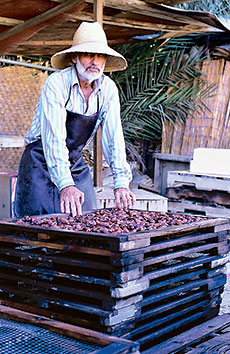 |
 |
| Khadrawy dates are arranged in racks, washed and dried. |
 |
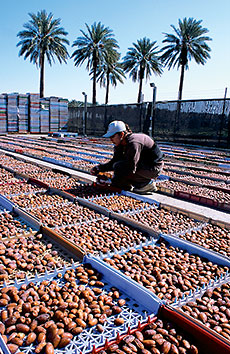 |
 |
| In tray after tray, medjool dates are turned by hand to ripen evenly. |
One of the most important individuals in the California date industry—now largely forgotten—was Abderahman bin Ali bin Haouffef. He came from the Algerian oasis of Tolga and, in 1913, took the American date palm buyer Henry Simon deep into the Algerian Sahara, to Touggourt and Quargla Oasis and beyond, to buy deglet noor palm offshoots. When Simon had described his proposed itinerary to the French colonial police on the coast, he was told that they could not guarantee his safety, and that he was risking his life to visit the deep Sahara. In the end, however, Haouffef, with his connections and his local horticultural knowledge, made it possible for Simon to buy nearly 6000 offshoots. He arranged Simon’s introductions to the local shaykhs, facilitated the selection process, checked the quality, arranged terms of payment and helped to organize armed camel caravans to the nearest port.
From the coast, palm offshoots were shipped to the United States by steamer, arriving several months later in Thermal, California. They were closely planted out and helped form the beginning of the West India Gardens, the first wholesale date palm nursery in the area. From 1913 until around 1922, huge numbers of date palm offshoots continued to be brought to the Coachella Valley by others, establishing the area as the date-growing capital of the United States. Today, there are more than a quarter-million palms in the region, and they produce 95 percent of the national crop.
 nce I arrived in Thermal, my first stop was at the Oasis Date Garden. Set on the west side of the “Date Highway” (officially Highway 111) , the Oasis Date Garden was founded by Ben Laflin, Sr. in 1912. His son, Ben Laflin, Jr., is one of the most successful and influential date growers in the Coachella Valley. His success is due partly to his knowledge of irrigation, but primarily to his wise decision to plant medjool dates—locally referred to as “the Cadillac of dates.”
nce I arrived in Thermal, my first stop was at the Oasis Date Garden. Set on the west side of the “Date Highway” (officially Highway 111) , the Oasis Date Garden was founded by Ben Laflin, Sr. in 1912. His son, Ben Laflin, Jr., is one of the most successful and influential date growers in the Coachella Valley. His success is due partly to his knowledge of irrigation, but primarily to his wise decision to plant medjool dates—locally referred to as “the Cadillac of dates.”
The medjool comes from the Boudenib Oasis in Morocco. Its name—from the Arabic verb jahal, “to be ignorant”—means “unknown,” a surprising choice for what is now probably the best-known “boutique” date widely available in the US and Europe. In terms of flavor, texture, attractive appearance and, above all, size—three by five centimeters, or 1 11/44 by 2 inches—it stands out from all the others. It has an attractive, deep reddish-brown color with the skin adhering to the flesh. The translucent, dark amber flesh is chewy, rich and delicious. It ships well and, after the deglet noor, is the second most important commercial date in California.
Tim Burke, the general manager at Oasis, told me how the medjool date originally came to California. In 1927, Walter Swingle, a horticulturalist employed by the usda, was in Morocco on date business. A date disease was decimating the medjool date population there, but Swingle managed to find an isolated oasis where he obtained 11 medjool offshoots to take back to California. To avoid the possibility of spreading the disease, these medjool offshoots were planted in a remote desert region in southern Nevada near the California border. A well was dug, and for the next seven years the offshoots were tended by the Johnsons, an elderly Native American couple. The Johnsons’ dogs dug up two of the offshoots, but the nine surviving palms not only eventually became the breeding stock for all medjool dates that now grow in the us, but also later served to restock medjool date groves in Morocco.
 |
 |
| Tools of a palmero’s trade include a basket (canasta) and a machete; this one is handmade from an automobile leaf spring. |
In 1939, Ben Laflin, Sr. obtained 24 offshoots from the original nine medjool palms, and from these he began the long process of planting out the trees, collecting the best offshoots and slowly expanding the Oasis Date Garden to its present size of 70 hectares (175 acres) with nearly 8500 palms. Each year, Oasis sells about 410,000 kilograms (900,000 lb) of certified organic, hand-sorted, boxed medjool dates, and some 22,000 kilograms (50,000 lb) of various other varieties—including one of my favorites, the halawy (“sweet one”), an excellent, medium-sized, amber-colored, soft date from southern Iraq.
Seasonally, Oasis also sells “Ramadan” or “yellow-end specials,” very moist and attractive rehydrated tamr medjool dates marketed to Muslim communities around Ramadan, when pallet-loads are shipped to mosques, community centers and Islamic schools in Florida, Iowa, Arkansas, Arizona, Minnesota, the Pacific Northwest and elsewhere.
As a matter of curiosity, I asked Tim whether he still ate dates outside his quality-control work, and whether he had a favorite variety or a preferred way of eating them. Without hesitation, he smiled and told me to try quarter-cut frozen tamr barhi dates on vanilla ice cream. All dates freeze well, and their high sugar content prevents them from freezing hard: They merely become more chewy. “Dates are an excellent source of potassium and iron,” he said, “and they have a sugar content of 80 percent or higher.” One date contains approximately 21 to 23 calories, and a steady diet of dates has been linked to very low rates of heart disease and cancer.

 he following morning, shortly after sunrise, at the base of a 25-meter (80') date palm, I scribbled notes while trying to avoid the shower of dates that fell from above. Standing next to me was Robert Lower from the Flying Disk Ranch. We were in a large commercial date grove less than a mile from where Lower’s pampered, organically grown date palms are lovingly tended by hand. He wanted to show me how the big companies harvest deglet noor dates. High above us, at the top of the palm tree, was palmero Carlos Rodrigues. Palmero is Spanish, a term of respect for one of the highly skilled and fearless palm-tree workers. On the tallest palms, such as these, a palmero first climbs to the very top of a 16-meter (52') aluminum extension ladder. Then he must ascend a series of ladders that are chained to the tree crown.
he following morning, shortly after sunrise, at the base of a 25-meter (80') date palm, I scribbled notes while trying to avoid the shower of dates that fell from above. Standing next to me was Robert Lower from the Flying Disk Ranch. We were in a large commercial date grove less than a mile from where Lower’s pampered, organically grown date palms are lovingly tended by hand. He wanted to show me how the big companies harvest deglet noor dates. High above us, at the top of the palm tree, was palmero Carlos Rodrigues. Palmero is Spanish, a term of respect for one of the highly skilled and fearless palm-tree workers. On the tallest palms, such as these, a palmero first climbs to the very top of a 16-meter (52') aluminum extension ladder. Then he must ascend a series of ladders that are chained to the tree crown.
Watching Rodrigues at the top of the swaying tree made me think of a rock climber or a trapeze artist. Seated in a date picker’s saddle, suspended at the end of a heavy chain harness, Rodrigues swung around the tree just below the green canopy of fronds as he hacked off fruit stalks laden with bunches of dates. Rodrigues was wielding a hand-forged machete and wearing a heavy leather gauntlet designed to protect his wrist from the formidable mass of needle-sharp spines that grows at the base of each frond. Several detached date stalks were hung on a long metal hook at his waist and then periodically lowered by rope to his assistant on the ground, Hector Morales. Morales maneuvered the heavy clusters into a large collection box. The sun was hardly above the horizon, yet these two men had already filled two boxes.
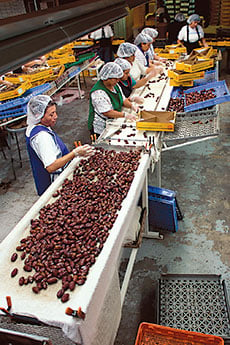 |
 |
| Grading, sorting and packing dates for the US market means gentle handling at the Oasis Date Garden. Both taste and appearance affect the success of a crop. |
Date palm cultivation is labor intensive. In nature, date palms are wind-pollinated, which is a very inefficient way to produce fruit. Therefore, a palmero must collect pollen from the male tree, then climb all of the female trees and hand-pollinate the flowers with powder-puff applicators. During the year, a palmero must climb each palm more than a dozen times: Besides doing the pollinating, he dethorns the fronds, cuts away dead fronds, thins the fruit to improve the air circulation needed for size and quality, ties down the young fruit stalks for ease of picking, wraps inverted waxed-paper cones over the fruit clusters to protect them from damaging rain, attaches fine mesh bags to keep out insects, rodents and birds, and finally climbs the trees four or five times to harvest the dates as they ripen through each phase.
“These are what we call ‘grinders,’” Lower said as he picked up a date from the ground. “Dates that are too dry to put in gift packs. The flavor is good, but they don’t present well. Some will be rehydrated in the packing house, but most of them are ground up to flavor packaged baked goods.”
I selected a date out of the box, brushed off the dust and took a bite. It tasted fine to me. Lower told me that eating a “natural” rutab date with a moisture content around 25 percent was a completely different experience. We returned to the Flying Disk Ranch, and there I was introduced to my first naturals—fully sun-ripened, soft dates, right off the tree.
Pedro and Carolina, the date pickers at the Flying Disk Ranch, were busy picking barhi and khadrawy dates. The khadrawy (“verdant”) ripens early in the Coachella Valley, around mid-September. This date variety, which is usually eaten in the rutab state, is from Basra, where well-to-do families traditionally offer it to honored guests. Its flesh has an extremely rich and pleasant flavor, and it is known for producing a heavy crop in California. The derrie (or dayri), another of Lower’s dates, also comes from the arid lands of southern Iraq, and it is unusually drought-resistant, able to subsist on 25 percent of the water other varieties need. Before leaving, I asked Lower if he knew anyone who grew the khalasah.
“Khalasah?” he said. “Never heard of it.”
I was not too surprised. More than 400 different varieties of dates have been grown experimentally in various parts of the US—mainly in Florida, Texas, Arizona and California—yet only a handful of these varieties are grown commercially in California. The commercial dates have been selected over time on the basis of yield per tree and per hectare, resistance to disease, Americans’ taste preferences and the packing and shipping requirements of large-scale facilities. The taste of the ripened fruit is only one of many factors one considers when planting a commercial date grove.
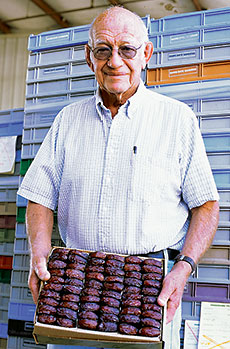 |
 |
| Ben Laflin’s father pioneered California’s medjool groves, and when he was well-established, Moroccan growers came back to him to replenish their own groves following an epidemic. His jumbo medjools, shown here, are for sale; his few khalasahs are a private reserve. |
 |
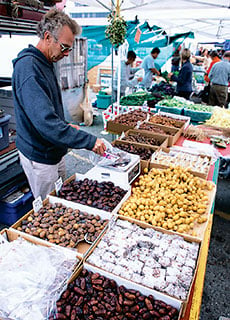 |
 |
| Lower sells his organic dates to urbanites at San Francisco’s Farmer’s Market. |
 |
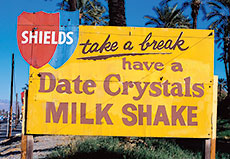 |
 |
| If you can’t drive the “Date Highway” to the Coachella Valley for this roadside treat, do the next best thing: pit the freshest dates you can find and toss them into a blender with crushed ice, milk and vanilla ice cream. |
 efore leaving the Coachella Valley, I made a last visit to the Oasis Date Garden. It was a hot, dusty day, and I wanted to try one of their famous date milkshakes. I also had to pick up an order of dates I had promised to friends at a neighborhood mosque in San Francisco. I ran into Ben Laflin, who was visiting for the day. We talked about the early days of date growing in the Valley, and we discussed the more obscure varieties. I asked him if he had ever heard of a date called khalasah. He eyed me carefully, and then paused for a few moments before answering.
efore leaving the Coachella Valley, I made a last visit to the Oasis Date Garden. It was a hot, dusty day, and I wanted to try one of their famous date milkshakes. I also had to pick up an order of dates I had promised to friends at a neighborhood mosque in San Francisco. I ran into Ben Laflin, who was visiting for the day. We talked about the early days of date growing in the Valley, and we discussed the more obscure varieties. I asked him if he had ever heard of a date called khalasah. He eyed me carefully, and then paused for a few moments before answering.
“Where did you hear about the khalasah?” he asked.
“From a man I met in Yemen, just south of the Rub’ al-Khali, the Empty Quarter of Saudi Arabia,” I replied.
“That man knows his dates,” Ben said.
To my surprise, the Oasis Date Garden actually has one khalasah palm. It is tucked away in a remote section of the acreage. Along with other varieties, khalasah offshoots were first brought to the Valley in 1912 from al-Hasa, the largest oasis in eastern Saudi Arabia, long famous for its dates. California growers experimented with the date because of its superior flavor, Ben said, but it didn’t ship well because it was too soft.
“It is a shame that this particular date wouldn’t go through a packing house in good shape, because the texture and flavor are unique,” he said.
His khalasah dates, he added, were not for sale. The harvest is well under 100 kilograms (220 lb) per year, and the lone khalasah palm is part of Ben’s private collection, a sentimental reminder of his early days as one of the country’s pioneering date growers. He gives the khalasah dates to friends and people in the trade who appreciate the exquisite taste. He was generous, and that evening I drove home with two boxes of jumbo medjools, one box of halawys and a single precious packet of a dozen rutab khalasah naturals.
Since my trip to the Coachella Valley, I have eaten dates many different ways: I have baked them in apples and prepared date-nut bread—a waste of good dates—and frequently I eat them plain with a sip of buttermilk for breakfast. Sliced medjool dates with slivered red onions, julienned jicama, baby greens and mandarin orange segments, all tossed with a light vinaigrette, make a refreshing salad. Pureed dates are indeed delicious in milkshakes. I highly recommend halawy dates stuffed with a bit of fromage blanc or ripened goat cheese. Quarter-cut frozen barhis on vanilla ice cream are nothing less than addictive.
As for my meager supply of khalasahs, however, I wasn’t sure how to eat them, until I remembered my experience in Wadi Hadhramawt. I have now come to the conclusion that the best way to eat the khalasah is to simply let a single date melt in my mouth—once a month. How to describe the experience? The khalasah has a tender, sticky, light orange-brown, silky skin. It possesses a translucent, reddish-amber, firm, delicate and complex caramel-flavored flesh that melts away to nothing. This is the sort of date that one can actually savor for an hour, exploring the entire range of date flavors, without being able to untangle the elusive flavor puzzle. I am now down to nine khalasahs, and I am thinking that my next trip in search of dates might need to go farther afield than the Coachella Valley.
 |
Eric Hansen (ekhansen@ix.netcom.com) is an internationally known author, lecturer and photojournalist living in San Francisco. A specialist in the traditional cultures of Southeast Asia and the Middle East, he is a frequent contributor to Saudi Aramco World. |